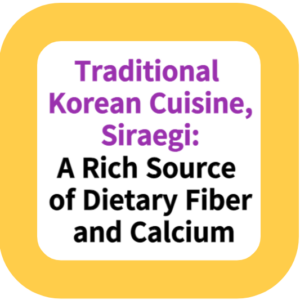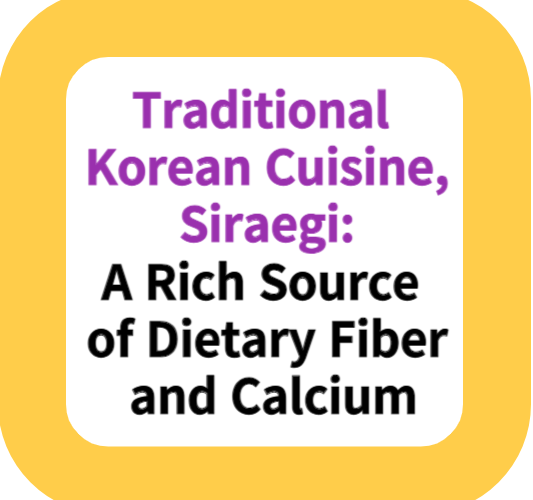Traditional Korean Cuisine, Siraegi: A Rich Source of Dietary Fiber and Calcium
Welcome to our latest blog post where we explore the remarkable transformation of Siraegi from a humble leftover in traditional Korean cuisine to a modern superfood. In this insightful journey, we delve into the rich nutritional profile of Siraegi, revealing its high dietary fiber and calcium content that has catapulted it into the limelight of health and wellness trends.
We discuss its myriad health benefits, ranging from digestive health to muscle nutrition, and its unexpected role as a non-dairy calcium powerhouse. Our post also highlights the unique culinary versatility of Siraegi, from its synergistic combination with Doenjang for enhanced flavor and health benefits to its ability to elevate fish dishes to new heights.
Join us as we rediscover this traditional ingredient and embrace its potential in modern cuisine, showcasing how Siraegi is not just a nod to cultural heritage but a step towards a healthier, more balanced diet.
Traditional Korean Cuisine, Siraegi: A Rich Source of Dietary Fiber and Calcium

Introduction: Siraegi – A Traditional Food Turned Modern Superfood
Siraegi, the dried leaves of radish, traditionally a staple in Korean cuisine post-kimchi preparation, has recently seen a resurgence as a modern superfood. With an increasing focus on health and wellness, the nutrient-rich profile of siraegi, abundant in dietary fibers and calcium, has captured the attention of health-conscious individuals.
Its transition from a traditional leftover to a sought-after ingredient reflects a broader trend in rediscovering and valuing ancient dietary wisdom. This versatile ingredient is now prominently featured in various recipes, ranging from traditional siraegi soups to innovative culinary creations.
Nutritional Profile: A Powerhouse of Digestive and Muscle Health
Siraegi stands out as a nutritional powerhouse, particularly beneficial during the winter months when certain nutrients are scarce. It’s packed with essential vitamins, calcium, iron, and notably high in dietary fibers. According to comprehensive nutritional databases, 100g of siraegi contains about 4.3g of dietary fiber and 1.58g of protein, with a very low calorie count of just 23 kcal.
The high fiber content not only aids in digestive health by cleansing the intestines but also plays a crucial role in reducing harmful cholesterol and triglycerides. This makes siraegi an excellent food choice for combating obesity and managing blood sugar levels, critical components in maintaining overall health.

Calcium Richness: A Viable Alternative to Dairy
One of the most remarkable aspects of siraegi is its calcium content, which rivals that of dairy products. With 108mg of calcium per 100g, it offers a viable alternative for those seeking non-dairy sources of this essential mineral. Regular consumption of siraegi can significantly contribute to bone health, a concern for many, especially as they age.
This aspect is particularly crucial in culinary practices that combine siraegi with calcium-rich fish, creating dishes that are not only delicious but also incredibly nutritious.
Siraegi and Doenjang: A Synergistic Combination for Health
The combination of siraegi and doenjang (Korean fermented soybean paste) is not only a culinary delight but also a synergistic blend for health benefits. Siraegi contains compounds like indole and isothiocyanate, which have been linked to reducing the risk of cancers, particularly in the colon.
Doenjang is rich in compounds like phytic acid and isoflavones, known for their potential in easing menopausal symptoms and reducing the risk of breast and uterine cancers. Incorporating these ingredients into dishes like siraegi doenjang soup or namul can provide these health benefits, as long as the salt content is kept in check.
Culinary Flexibility: Enhancing Fish and Other Dishes
The culinary applications of siraegi are vast and varied. It’s an adaptable ingredient that can be incorporated into side dishes, soups, stews, and even mixed into rice for an added nutritional punch. Its unique ability to complement fish dishes, like mackerel stew, is particularly noteworthy.
Siraegi not only improves the texture and flavor but also helps in reducing the fishy odor, making the dish more palatable. The combination of the proteins and unsaturated fatty acids in fish with the nutrients in siraegi results in a well-rounded, nutritious meal.
Conclusion: Embracing Siraegi in Modern Cuisine
Siraegi, with its rich history and nutritional profile, is more than just a traditional Korean food; it’s a testament to the timeless wisdom of using natural, wholesome ingredients. As we navigate through modern dietary trends, the resurgence of siraegi reminds us of the importance of incorporating nutrient-dense, natural foods into our diets.
Whether used in traditional recipes or innovative culinary experiments, siraegi offers a unique blend of taste and health benefits, making it an essential component of a balanced diet, particularly during the colder months. Embracing siraegi in daily cooking is not only a nod to cultural heritage but also a step towards a healthier lifestyle.

